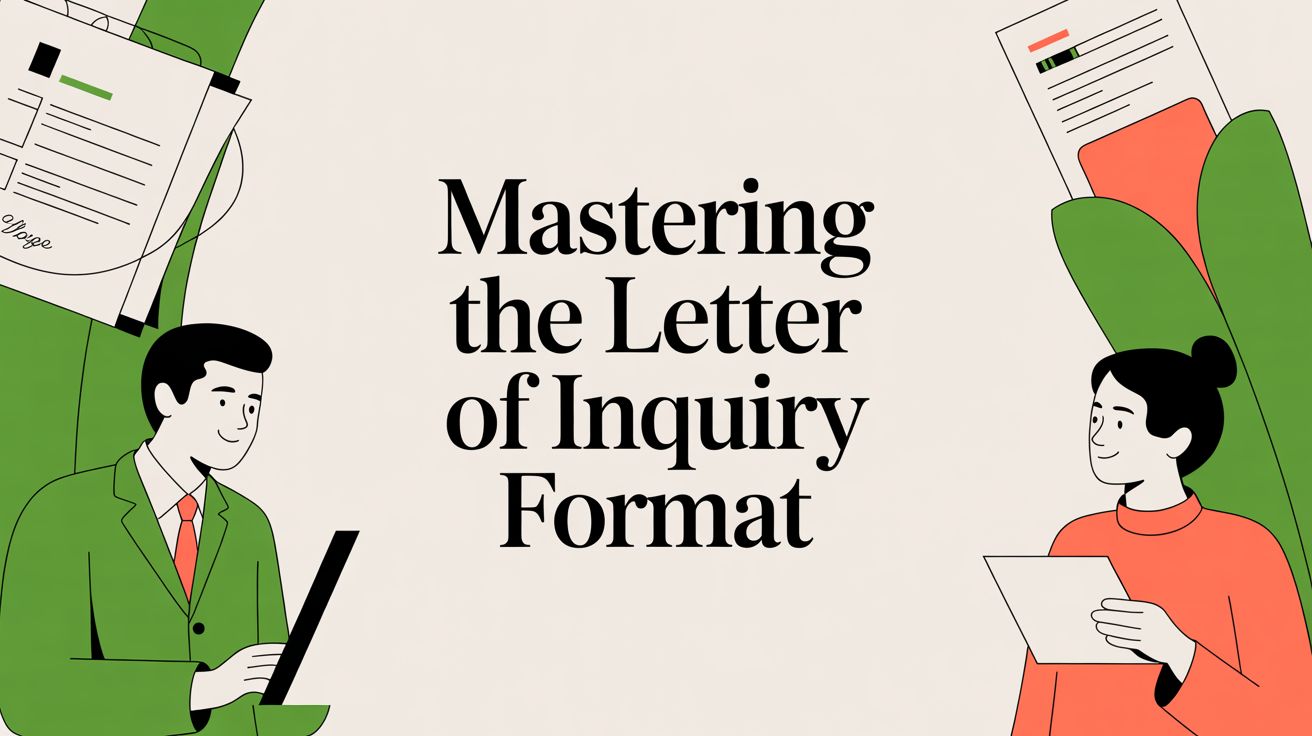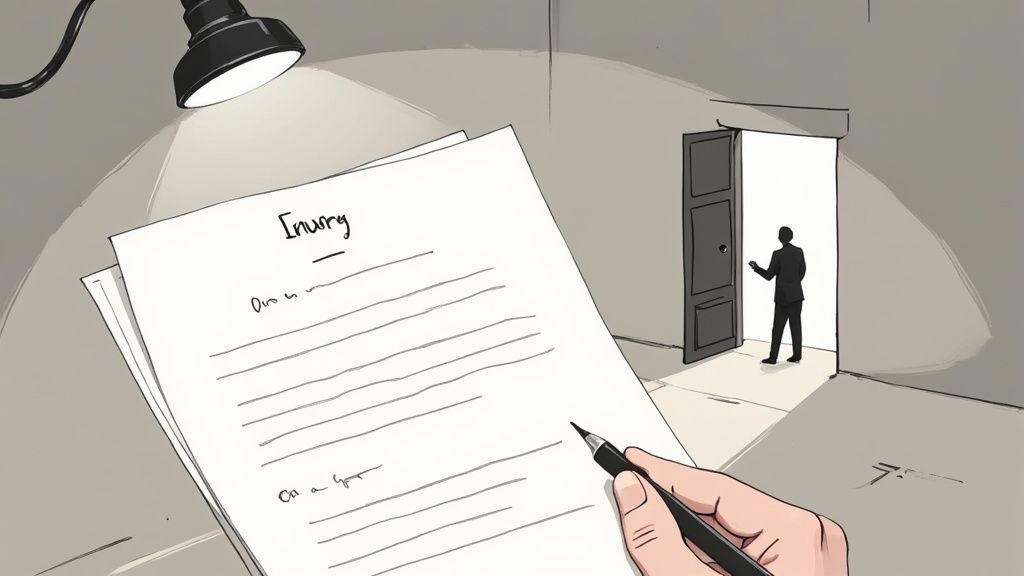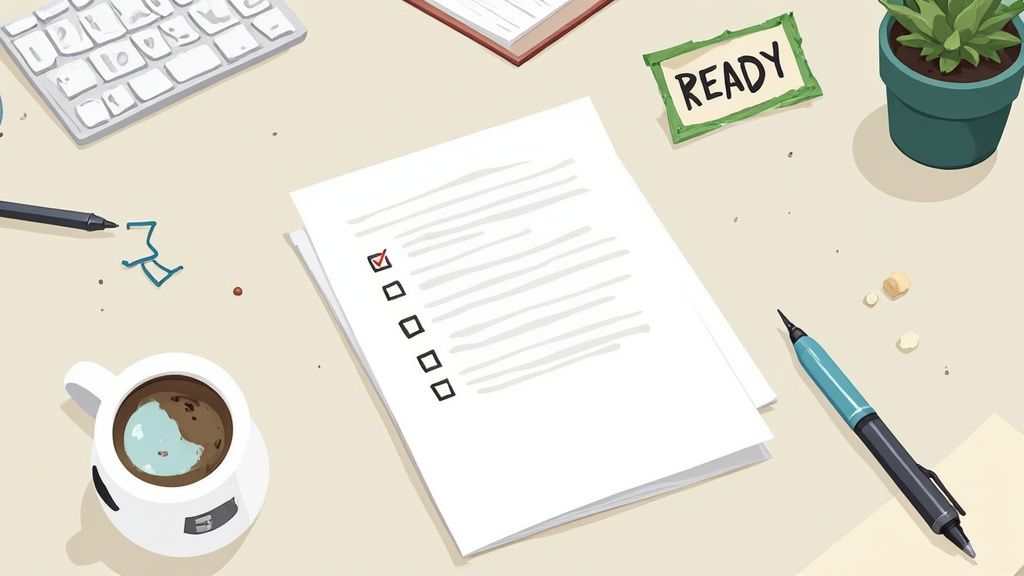Mastering the Letter of Inquiry Format
Unlock grant funding with our expert guide to the letter of inquiry format. Learn to craft a compelling LOI that gets noticed and secures funding.

A letter of inquiry, or LOI, is your secret weapon in the grant-seeking world. Think of it as a concise, powerful preview of your project, sent to a foundation to see if you’re a good fit before you sink countless hours into a full-blown proposal. It’s your handshake, your elevator pitch, and your best chance to make a stellar first impression.
Why Your Letter of Inquiry Is Your Most Important First Step

Before you even think about writing a massive grant proposal, most foundations will ask for an LOI. This isn't just another piece of paperwork; it's a critical tool that saves everyone time and headaches. For the grantmakers, it’s a highly effective filter.
This short document helps them quickly sift through the noise and zero in on projects that actually align with their mission. In fact, some foundations report a 40-50% drop in unsuitable applications just by requiring an LOI first. That frees up their review teams to give real attention to proposals—like yours—that have genuine potential. You can get more background on this trend from recent industry analyses.
Shifting from Requirement to Opportunity
It’s easy to see the LOI as just another hoop to jump through, but that’s the wrong mindset. A sharp, compelling letter is a strategic opportunity. It cuts through the clutter, builds your credibility, and can open the door to a conversation that ultimately gets you funded. This is your chance to prove you’re worth a closer look.
A strong Letter of Inquiry doesn’t just ask for money; it invites a partnership. It demonstrates that you understand the funder’s vision and are the perfect organization to help bring that vision to life.
For your nonprofit, the benefits are even clearer. Why spend 40+ hours crafting a detailed proposal only to have it tossed aside because it wasn’t a good fit? The LOI lets you test the waters quickly and efficiently. This means your team can stop chasing dead ends and focus its energy on the funders who are most likely to say "yes." Nailing the letter of inquiry format helps you state your case with confidence right from the start.
Before we dive into the nitty-gritty of each section, let's get a bird's-eye view of what makes up a solid LOI. Think of this table as your blueprint.
Core Components of a Winning LOI
Keep these core pieces in mind as we break down how to write each one. They are the essential building blocks for a letter that gets results.
Crafting an Introduction That Captures Attention

Let's be blunt: you have about ten seconds to make a grant reviewer care. Your introduction isn't the time for a lengthy mission statement or a deep dive into your organization's history. It's your hook—a direct, powerful opening designed to immediately connect your work to what the funder cares about.
The goal here is to get straight to the point. Your very first paragraph should clearly state who you are, what you plan to accomplish, and exactly how much funding you need. This isn't being pushy; it's being respectful of the reviewer's time and showing them you have a solid, well-defined plan. Think of it as the thesis statement for your entire request.
Building an Immediate Connection
So, how do you do this? Ditch the generic language and start with a compelling statement that frames the problem you're solving.
For example, instead of a flat opening like, "We are a nonprofit dedicated to literacy," try something with more punch: "Every year, 30% of third graders in our city are left behind due to low reading proficiency. Our organization, Literacy Forward, respectfully requests $25,000 to implement a proven after-school tutoring program designed to close this critical gap."
See the difference? That second example accomplishes several things all at once:
- It highlights the problem: The specific statistic creates an immediate sense of urgency.
- It introduces your organization: You're positioned as the direct solution to that problem.
- It states the ask: The funding amount is clear and upfront, with no guesswork needed.
This kind of directness builds a strong foundation for the rest of your letter and establishes your credibility from the first sentence.
An effective opening doesn't just introduce your project; it makes the funder feel that their investment is both urgent and inevitable. It frames your request as a partnership to solve a problem they already care about.
By crafting a concise and powerful opening, you turn your letter from a simple request into a compelling invitation to collaborate. It sets a positive, professional tone for everything that follows.
Presenting the Problem with Data and Heart

Once you've hooked them with a strong opening, it's time to make an undeniable case for your project. This is where you move past your mission statement and paint a vivid, urgent picture of the problem you're poised to solve. The secret here? A powerful blend of cold, hard data and compelling human stories.
Simply saying "poverty is a problem" won't cut it. Funders are inundated with requests tackling big issues. Your job is to make the problem feel local, tangible, and immediate. Dig up local statistics, demographic info, and community-specific data to build a narrative that a grant reviewer simply can't ignore.
Grounding Your Narrative in Facts
The goal is to frame a massive issue as a solvable, local challenge. You need to show that you have an intimate understanding of the landscape. For example, don't just say, "many children in our city are hungry."
Instead, try something like this: "In our county, 22% of elementary school students rely on free or reduced-price lunch, and a recent community survey found that 1 in 4 of those families report running out of food before the end of the month."
That kind of specificity accomplishes two critical things:
- It builds your credibility. You're not just passionate; you're an expert who has done the homework.
- It creates real urgency. Concrete numbers make the problem feel measurable and real, not abstract and overwhelming.
The most powerful problem statements don't just list facts—they use facts to tell a story. They connect a statistic to a face, a number to a need, and a challenge to a clear opportunity for impact.
This section is, for all intents and purposes, your needs statement. It's a cornerstone of any grant application. By focusing on a specific, data-backed need, you set the stage perfectly for presenting your project as the clear and necessary solution. For a deeper dive, check out our guide on what is a needs statement and how to perfect it.
Why Data Makes a Decisive Difference
Let's be clear: including solid data isn't just a "nice to have." It's a proven strategy that dramatically increases your odds. Recent analysis shows that LOIs using specific statistical data have acceptance rates 2.5 times higher than those that rely only on storytelling.
Even more telling, a 2023 study found that applications with at least three specific data points saw a 68% advancement rate to the full proposal stage. The rate for those without? A mere 27%. The numbers don't lie. You can find more insights on writing a compelling letter of inquiry on nonprofitinsights.org.
Describing Your Solution and Budget Needs
Once you’ve painted a clear picture of the problem, it’s time to pivot to your solution. This is your moment to connect the dots for the funder, showing them exactly how their support will translate into real-world impact. Vague promises won’t cut it here; you need to get specific about what your project actually involves.
What will you do? Talk about the core activities. Are you planning to run a series of workshops? Maybe you're setting up a one-on-one mentoring program or distributing food packages. Spell out the concrete actions your team will take. You'll also want to be crystal clear about who you’re helping and how you’ll find them. This shows the funder you’ve thought through the logistics and have a solid plan.
Then, you need to talk about what's going to change because of your work. What are the expected outcomes? Try to put these in terms you can measure. For example, instead of saying you'll "improve literacy," you could say you aim to "increase reading proficiency by 15% among third-graders" or "serve 200 additional families this year."
Presenting Your Budget Request
Let's talk money. This part of the letter of inquiry format can feel a bit daunting, but it doesn't have to be. The trick is to be direct, honest, and realistic. Think of your budget request as more than just a number—it’s a snapshot of your project's planning and your organization's ability to get things done.
You’ll want to state two key figures very clearly:
- The total project cost: This gives the funder the full picture of what it takes to run your initiative.
- The specific amount you are requesting from them: This is your straightforward ask.
Here’s a real-world example of how that might look: “The total budget for our 'Youth Coders Initiative' is $75,000. We are requesting $25,000 from the Tech Forward Foundation to specifically cover the costs of our coding instructors and classroom technology.”
A well-presented budget request builds confidence. It tells the funder you've done your homework and have a responsible plan for their money. It's not just an ask—it’s proof of your preparedness.
For a letter of inquiry, presenting these top-line figures without a line-by-line breakdown is perfectly normal. The idea is to provide a clean financial overview that feels ambitious but grounded. If you need a hand getting your numbers in order, our grant proposal budget template is a great place to start.
Putting the Final Polish on Your Letter of Inquiry

You’ve done the hard work of laying out the problem and your brilliant solution. Now for the crucial last step: making sure the letter itself looks as professional as the project it represents.
Don't let sloppy formatting undermine a powerful idea. A polished, well-structured letter tells a funder you're a serious organization that pays attention to detail—exactly the kind of partner they want to invest in.
Think of it like this: the standard business letter format is your non-negotiable foundation. Make sure you’ve included your contact info, the date, the funder's details, a proper salutation, and a closing like "Sincerely," followed by your name and signature. These small things add up to create a powerful first impression of competence.
Striking the Right Tone and Following the Rules
The voice of your letter needs to walk a fine line. You want to be professional but also convey a genuine passion for your work. Keep your language clear and direct, and steer clear of overly academic jargon that can muddy your message.
But here’s the most critical piece of advice: follow the funder’s guidelines to the letter. If they say two pages max, sending three is a fast track to the “no” pile. If they want 12-point Times New Roman font, don’t get creative. Ignoring their rules signals you can't follow directions, which is a massive red flag for any grantmaker.
The final review is about more than just typos. It's your last chance to make sure every single element—from formatting to tone—screams competence and professionalism. How you present your letter is a direct reflection of how you’ll manage their grant.
Your Pre-Flight Checklist
Before you even think about hitting "send," do one last pass to catch those little mistakes that can trip you up.
- Proofread like a hawk. Read it out loud. You'll be amazed at the awkward sentences you catch. Have a colleague give it a fresh look, too.
- Is the "ask" obvious? Make sure your funding request is crystal clear and easy for a reviewer to spot. Don't make them hunt for it.
- Double-check the alignment. Reread the funder’s priorities. Does every part of your letter clearly connect back to what they care about?
Taking the time for this final polish can be the difference between a letter that gets a second look and one that gets tossed. To see how all these pieces come together, check out this sample letter of inquiry for grants for a bit more inspiration.
Answering Your Top Questions About Writing an LOI
Even if you've been writing grants for years, a letter of inquiry can still throw you for a loop. Every foundation has its own quirks, but after seeing thousands of these, I can tell you the same questions pop up over and over again.
Let's clear up some of that confusion so you can hit "send" with total confidence.
One of the first things everyone asks is, "How long should this thing be?" It's a great question. While you should always defer to the funder's specific guidelines, the unwritten rule is to keep it between one and three pages.
That usually works out to somewhere in the ballpark of 750-1,200 words. That’s the sweet spot—enough space to make a compelling case without making the reviewer's eyes glaze over. If a foundation doesn't give you a page limit, a strong, concise two-page letter is almost always your best bet.
Nailing the Small (But Important) Details
What about the budget? This is another common hang-up. You might be tempted to attach a detailed spreadsheet, but hold off. For an LOI, that's overkill.
All you really need are two numbers: the total cost of the project and the exact amount you’re requesting from the foundation. You can follow that up with a simple sentence to add context, something like, "The requested funds will cover salaries for our two lead instructors and program supplies." That's it.
And finally, who do you actually address the letter to? Please, avoid "To Whom It May Concern." It feels dated and impersonal. Do a little digging on the foundation’s website for a Grants Manager or a specific Program Officer. If you come up empty-handed after a thorough search, addressing it to the "Dear Grants Committee" is a professional and perfectly acceptable alternative.
What about following up? It can feel awkward, right? If the guidelines don't give you a response date, give them at least a month before reaching out. A quick, polite email to confirm they received your LOI and ask about the timeline is all you need. Keep it brief and professional.
Ready to stop chasing grants and start winning them? Fundsprout uses AI to find your perfect funding matches and helps you write compelling proposals faster. Discover how Fundsprout can transform your grant-seeking process today.
Try 14 days free
Get started with Fundsprout so you can focus on what really matters.
